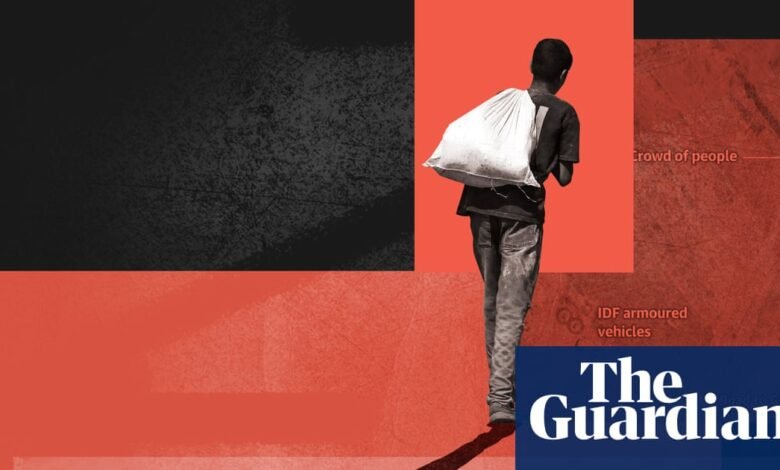‘A deadly scheme’: Palestinians face indiscriminate gunfire at food sites | Gaza

Warning: includes images of blood and graphic scenes
Ehab Nuor, a 23-year-old barber, lies flat on the sand behind entangled metal, hiding from heavy machine-gun fire, as hundreds of Palestinians scramble away, carrying backpacks in which they had hoped to collect food.
Nuor has come under fire from the Israeli military near food distribution centres on more than 10 occasions.
A Guardian investigation analysing visual evidence, bullets, medical data and patterns of injuries from two hospitals, as well as interviews with medical organisations and surgeons, across approximately 50 days of food distribution, appears to show a sustained Israeli pattern of firing on Palestinians seeking food.
The Guardian studied more than 30 videos of gunfire near food distribution sites run by the US and Israeli-backed Gaza Humanitarian Foundation (GHF). More than 2,000 Palestinians were injured during the 48 days investigated, mostly by gunshots.
In the footage, machine-gun fire can be heard on at least 11 days near the food distribution sites. Bullet casings recovered from patients, and patterns of fire analysed by weapons experts, suggest they were Israeli munitions.
Palestinians, like Nuor, who travel to GHF sites have come under systematic and indiscriminate Israeli gunfire.
Doctors at Nasser hospital in Khan Younis and the Red Cross field hospital in Rafah described treating an unprecedented number of gunshot wounds. Almost all responsive patients arriving at the field hospital say they were shot by the Israeli military while trying to reach a food distribution site.
The International Committee of the Red Cross (ICRC) said the casualty numbers were higher than the combined number of patients they had treated during mass-casualty incidents over the entire previous year. In data seen by the Guardian, more than 100 of these patients were declared dead on arrival.
Just last week, Nuor dodged bullets again: “This is how we get flour in Gaza. We just want to live – enough is enough.” In one video, an Israeli tank is clearly visible, and gunshots can be heard.
According to the UN, at least 1,373 Palestinians have been killed since 27 May while seeking food, with 859 killed in the vicinity of GHF sites and 514 along the routes of food convoys.
The bullets on the road
A long road runs near the GHF food site in northern Rafah, where crowds gather that are so large they can be seen from space.
It is here that Palestinians trying to get food have come under intense fire.
One clip from July shows the bullets hitting the sand as a row of Palestinians hide.
“The gunfire at us was random,” said Mohammed Sleiman Abu Lebda, 20, covered in bandages and watching the video on his phone from a hospital bed. He said he had been waiting for two hours at the distribution site when the Israeli military opened fire on the crowd.
The man beside him was torn apart, his remains carried away in the bag he had brought to collect flour, Lebda said.
Of the 21 days of shootings at food distribution sites in June in which about 2,000 Palestinians were injured, the Israeli military acknowledged opening fire on “suspects” or firing “warning shots” on eight occasions, but repeatedly denied targeting civilians. In some of these cases, it said it was aware of reports of injuries, and seven cases were “under review”. In several cases, the GHF denied there had been “an incident” in the immediate vicinity of its sites.
The British weapons expert Chris Cobb-Smith, commenting on the footage in which gunshots pepper the sand, said the action was “reckless and irresponsible”, adding: “There is no tactical reason to employ small-arms fire to that degree near crowds of non-combatants. It is utterly outrageous.”
Trevor Ball, an American weapons expert, said: “If this is intended as warning shots, it is an unsafe practice. Aiming that close to people creates a significant risk of harm or death. Bullets can ricochet, as well as have their trajectory affected by the wind and other non-human, as well as human, factors. These risks increase with distance.”
Images of eight bullets removed from people shot near GHF sites were shared with the Guardian by doctors from Nasser hospital.
The weapons experts analysed two of the bullets, using measurements.
Ball said: “These bullets are consistent with 7.62x51mm, a standard IDF [Israel Defense Forces] calibre. The other is .50 cal, which is used by IDF machine guns, and some Hamas sniper rifles.”
Cobb-Smith found the same calibres and concurred with Ball. He added it was difficult to be specific about the calibre of the other six bullets and attribute them without exact measurements, but that they were all high-velocity rounds, implying probable military issue.
‘A deadly scheme’
Prof Nick Maynard, a consultant surgeon at Oxford university hospital, has been visiting Gaza since 2010, and has completed three missions to Nasser hospital in Khan Younis since the start of the war. Speaking between surgeries, he said that since the GHF sites opened he had predominantly seen gunshot wounds.
Maynard said he had seen a clustering of similar injuries that coincided with the days when food was distributed – between six and 12 patients coming in with the same injuries – gunshots to the neck, head or arms. “The clustering of similar injuries in one day suggests this is a targeting activity at particular body parts.”
He added: “The other night, we admitted four teenage boys, all of whom have been shot in the testicles.”
Another surgeon at Nasser, Goher Rahbour, described treating an unusually high number of mass-casualty incidents, mostly young boys returning from GHF sites: “100% of the time, [they said] it’s from the Israeli forces.”
In Rafah, the 60-bed Red Cross field hospital received more than 2,200 patients from more than 21 separate mass-casualty incidents – those with more than 30 injured people at once – between 27 May, when the GHF sites opened, and 26 June, according to hospital admission records seen by the Guardian.
‘They are shooting at us’
The Israeli military has claimed Hamas is stealing aid, despite the European Commission finding no reports of this. At the end of May, the Israeli government promised to lift its siege of Gaza so the GHF could set up its centres. Veteran aid groups were denied entry.
From the start, the GHF distribution was violent, with more than 400 Palestinians injured in the first week alone, and more than 30 patients dead on arrival at the ICRC field hospital. The first food distribution site was in a zone in west Rafah flagged by Israel for evacuation. To collect food, Palestinians had to defy the orders.
Four days later, in June, sporadic machine-gun fire was heard near the GHF site in the early morning hours.
“They are shooting at us, I swear,” said 30-year-old Ameen Khalifa. “We come to get food for our lives, drenched in blood. We will die because we’re trying to get food.” About 170 Palestinians were injured that day, and 30 killed.
Khalifa survived, but not for long. His family said he was shot and killed in the same area two days later while trying to collect food.
“There is no arrangement, no order, no humanitarian conditions or anything that respects a human being,” Khalifa’s brother said in an interview from a camp for displaced people in Deir al-Balah, in central Gaza.
Israel’s military admitted firing “warning shots” toward individuals who approached its forces, and the GHF said food was handed out that day without incident.
Ahmad Zeidan, a young boy, had queued to collect food from 7pm the previous night with his mother and sister, after receiving word of the distribution from the Israeli military. He claimed the Israeli military opened fire. His mother was killed.
“I advise people not to go [to the food sites]. Damn this aid … Either we get them while maintaining our dignity, or we don’t want them. My mother is gone,” he cried outside Nasser hospital while waiting to collect her body.
The IDF said its forces had opened fire on a group of people they viewed as a threat but denied targeting civilians, adding that it was investigating the events. The GHF said the incident occurred in an area beyond their secure distribution site and control.
Ehab Nuor visited four food sites run by the GHF in June and July, and faced gunfire near all four. All of these sites were within areas the IDF designated for evacuation, placing Palestinians in direct danger.
Between 16 and 20 June, as the world focused on the war between Israel and Iran, the shootings intensified, injuring 600 Palestinians near food sites.
Videos show floodlights cutting through the dark around GHF sites, as an endless stream of Palestinians carry away white flour bags and gunshots ring out. Other videos show Palestinians huddled outside the perimeter of a GHF site, with gunshots audible.
Ball said machine guns were widely issued to IDF infantry and mounted on vehicles. By comparison, Hamas had some machine guns and captured IDF weapons but these were rarely seen except on ceremonial occasions.
All survivors and patients treated by doctors said they had come under Israeli fire.
The Israeli military released a video of an IDF spokesperson, Nadav Shoshani, standing near a GHF food site, saying: “The idea is to give aid directly to Gazan civilians and bypass Hamas’s hands … This is a new solution that brings aid directly to the people of Gaza … They have been going in and out peacefully …… They feel safe”.
But the evidence analysed indicates otherwise.
Under international humanitarian law, those involved in aid delivery and those backing its operations have a duty to ensure humanitarian assistance is provided safely, impartially, and without exposing civilians to additional risk, including ensuring safe access.
Reviewing the Guardian’s findings, Adil Haque, a professor of law at Rutgers University, New Jersey, said: “These are grave breaches of the fourth Geneva convention as well as war crimes under customary international law and the ICC [international criminal court] statute. A soldier may argue that they acted reasonably to defend themselves or others. However, it is neither reasonable nor proportionate to fire on unarmed civilians at a distance.”
Bushra Khalidi, Oxfam’s policy lead for the Palestinian territories, who has family members trapped in Gaza, believes this is not a humanitarian system. “It’s a deadly scheme,” she said.
Recent reports indicated that some members of the Israeli military had been ordered to open fire on civilians collecting food, while US contractors said their colleagues had fired live ammunition at Palestinians collecting food in Gaza.
An IDF spokesperson told the Guardian: “The IDF unequivocally denies the false allegation that it deliberately targets Palestinian civilians. The army’s binding orders prohibit forces operating in the area from intentionally firing at minors. The IDF operates according to international law and upholds the highest ethical standards in its operations.”
The IDF said it operated near the new distribution areas to “facilitate the aid efforts while continuing IDF operational activity in the Gaza Strip”, but did not confirm details of the review into incidents of civilian harm. It said that after an examination by its southern command, “instructions [were] issued to field forces following lessons learned”. It added that IDF forces had conducted “learning processes aimed at improving the operational response … and minimising possible friction between the population and the IDF” and this had been achieved through “the installation of fences, signage placement, the opening of additional routes, and other measures”.
A GHF spokesperson accused the Guardian of aiding a terrorist organisation and said: “The false and exaggerated statistics used in these reports seem to directly align with the Hamas-controlled Gaza health ministry … GHF has communicated to the UN and other humanitarian groups that we remain flexible and willing to sit down and address their concerns to find a path forward to collaborate and coordinate to securely deliver the maximum amount of aid possible.”
Earlier this week, the US ambassador to Israel called the GHF food distribution “phenomenal”, dismissing reports of IDF fire killing Palestinians as “nonsense”. He announced the possibility of opening 12 more food sites, and commencement of a 24 hour operation.
For Nuor, there is no respite. He now starves in a tent along with his family.
Additional reporting by Hoda Osman and Zarifa Abou Quora




